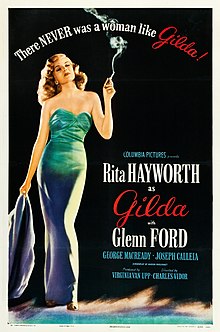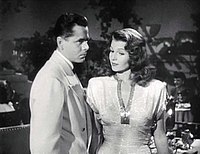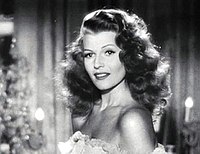Gilda
| Gilda | |
|---|---|
 Theatrical release poster, "StyleB " | |
| Directed by | Charles Vidor |
| Screenplay by |
|
| Story by | E.A. Ellington |
| Produced by | Virginia Van Upp |
| Starring | |
| Cinematography | Rudolph Maté |
| Edited by | Charles Nelson |
| Music by | M. W. Stoloff Marlin Skiles |
| Color process | Black and white |
Production company | Columbia Pictures |
| Distributed by | Columbia Pictures |
Release dates |
|
Running time | 110 minutes |
| Country | United States |
| Language | English |
| Budget | $2 million[1] |
| Box office | $6 million (rentals)[1] |
Gildais a 1946 Americanfilm noirdirected byCharles Vidorand starringRita HayworthandGlenn Ford.
The film is known for cinematographerRudolph Maté's lush photography, costume designerJean Louis's wardrobe for Hayworth (particularly for the dance numbers), and choreographerJack Cole's staging of "Put the Blame on Mame"and"Amado Mio",sung byAnita Ellis.Over the yearsGildahas gainedcult classicstatus.[2][3][4]In 2013, the film was selected for preservation in the United StatesNational Film Registryby theLibrary of Congressas being "culturally, historically or aesthetically significant".[5][6][7]
Plot
[edit]Johnny Farrell, an American newly arrived inBuenos Aires,Argentina,wins a lot of money cheating atcraps.He is rescued from a robbery attempt by a complete stranger, Ballin Mundson. Although Farrell is warned not to cheat at an illegal high-class casino he tells him about, he ignores his advice. After winning atblackjack,he is taken to see the casino's owner, who turns out to be Mundson. Farrell talks him into hiring him and soon becomes Mundson's trusted casino manager.
Mundson returns from a trip and announces he has an extremely beautiful new wife, Gilda, whom he has married after only knowing her for a day. Johnny and she instantly recognise each other from the past, though both deny it when he questions them. Mundson assigns Farrell to watch over Gilda. The pair are consumed with hatred for each other, and she cavorts with men at all hours in increasingly more blatant efforts to enrage Johnny, and in return he grows more spiteful towards her.
Mundson is visited by twoGermanmobsters. Their organisation had financed atungstencartel,with everything put in Mundson's name in order to hide their connection to it. They have decided that it is safe to take over the cartel now thatWorld War IIhas ended, but Mundson refuses to transfer ownership.
The Argentinian police are suspicious of the Germans and assign agent Obregón to try to obtain information from Farrell, but he knows nothing about this aspect of Mundson's operations. The Germans return to the casino during a carnival celebration, and Mundson ends up deliberately shooting and killing one of them..
Farrell rushes to take Gilda to safety. Alone in Mundson's house, they have another confrontation and, after declaring their undying hatred for each other, passionately kiss. After hearing the front door slam, they realise Mundson has overheard them, and a guilt-ridden Farrell pursues him to a waiting private airplane. The plane explodes in midair and plummets into the ocean. Mundson parachutes to safety. Farrell, unaware of this, concludes that he is dead.
Gilda inherits his estate. Farrell and she immediately marry, but unknown to her Johnny is marrying her to punish her for her betrayal of Mundson, which is hypocritical, since he also betrayed Mundson's trust. He abandons her, but has her followed day and night by his men to torment her. Gilda tries to escape the tortured marriage a number of times, but Farrell thwarts every attempt.
Obregón confiscates the casino and informs Farrell that Gilda was never truly unfaithful to Mundson or to him, prompting Farrell to try to reconcile with her as prepares to return home to the U.S.. At that moment, Mundson reappears, revealing his faked suicide. He tries to kill both Gilda and Farrell, but the casino worker, Uncle Pío fatally stabs him in the back. When Obregón arrives, Johnny tries to take the blame for the murder, but Obregón points out that since Mundson was already declared legally dead he can't arrest him.
Farrell gives Obregón incriminating documents from Mundson's safe. He and Gilda finally reconcile with an agreement to go home together.
-
Johnny Farrell (Glenn Ford) and Gilda (Rita Hayworth)
-
"Gilda, are you decent?"
Cast
[edit]
- Rita Hayworthas Gilda Mundson
- Glenn Fordas Johnny Farrell
- George Macreadyas Ballin Mundson
- Joseph Calleiaas Detective Mauricio Miguel Obregón
- Steven Gerayas Uncle Pío
- Joe Sawyeras Casey
- Gerald Mohras Captain Delgado
- Mark Robertsas Gabe Evans
- Ludwig Donathas German
- Don Douglasas Thomas Langford
- Lionel Royceas German
- George J. Lewisas Huerta
Cast notes
- Anita Ellisdubbed the singing voice of Rita Hayworth in all songs.[note 1]
Production
[edit]Gildawas developed by producerVirginia Van Uppas a vehicle for Hayworth, who had mostly been known for her roles in musical comedies at that time.[10]The story was originally set to be an American gangster film directed byEdmund Goulding.[11]However, the location of story was changed to Buenos Aires after objections from censorJoseph Breenand the replacement of Goulding withCharles Vidor.[11]
Gildawas filmed from September 4 to December 10, 1945.[10][11]During filming, Hayworth and Ford began an extensive affair that would last until Hayworth was diagnosed withAlzheimer's diseasein the early 1980s.[12][13][14][15]
Hayworth's introductory scene was shot twice. While the action of her popping her head into the frame and the subsequent dialogue remains the same, she is dressed in different costumes—in a striped blouse and dark skirt in one film print, and the more famous off-the-shoulder dressing gown in the other.[citation needed]
Reception
[edit]When first released, the film earned mixed to positive reviews.Varietyliked the film and wrote, "Hayworth is photographed most beguilingly. The producers have created nothing subtle in the projection of her s.a. [sex appeal], and that's probably been wise. Glenn Ford is the vis-a-vis, in his first picture part in several years...Gildais obviously an expensive production—and shows it. The direction is static, but that's more the fault of the writers. "[16]Reviewing the film forThe New York Times,Bosley Crowther gave the film a negative review, admitting he did not like or understand the movie, but praised Ford as having "a certain stamina and poise in the role of a tough young gambler."[17]
Gildawas screened in competition at the1946 Cannes Film Festival,the first time thefestivalwas held.[18]In its release, the film earnedtheatrical rentalsof $3,750,000 in the United States and Canada,[19]and $6 million worldwide.[1]
In retrospect, the film has become critically acclaimed. Review aggregatorRotten Tomatoesreported that 90% of critics gave the film a positive review, based on 67 reviews.[20]More recently, film criticEmanuel Levywrote a positive review: "Featuring Rita Hayworth in her best-known performance,Gilda,released just after the end of WWII, draws much of its peculiar power from its mixture of genres and the way its characters interact with each other...Gildawas a cross between a hardcore noir adventure of the 1940s and the cycle of 'women's pictures.' Imbued with a modern perspective, the film is quite remarkable in the way it deals with sexual issues. "[21]The A.V. Clubsaid "Part of Gilda's fascination is the way that it complicates the idea of thefemme fatale.(...) Hayworth plays Gilda with a layer of bravado that masks deep insecurity "but mentioned that the unusualhappy endingfor a noir almost ruined the film experience.[22]
Operation Crossroads nuclear test
[edit]
Attesting to its immediate success, it was widely reported thatan atomic bombto be tested atBikini Atollin theMarshall Islandswould bear the film's title above an image of Hayworth, a reference to herbombshellstatus. The bomb was decorated with a photograph of Hayworth cut from the June 1946 issue ofEsquiremagazine; above it was stenciled the device's nickname, "Gilda", in two-inch black letters.[23]
Although the gesture was meant as a compliment, Hayworth was deeply offended.[24]According toOrson Welles,her husband at the time of filmingGilda,Hayworth believed it to be a publicity stunt from Columbia executiveHarry Cohnand was furious. Welles told biographerBarbara Leaming:"Rita used to fly into terrible rages all the time, but the angriest was when she found out that they'd put her on the atom bomb. Rita almost went insane, she was so angry.... She wanted to go to Washington to hold a press conference, but Harry Cohn wouldn't let her because it would be unpatriotic." Welles tried to persuade Hayworth that the whole business was not a publicity stunt on Cohn's part, that it was simply homage to her from the flight crew.[25]: 129–130
Memorabilia
[edit]
The two-piece costume worn by Hayworth in the "Amado Mio" nightclub sequence was offered as part of the "TCM Presents... There's No Place Like Hollywood" auction November 24, 2014, atBonhamsin New York.[26]It was estimated that the costume would fetch between $40,000 and $60,000; in the event it sold for $161,000 (equivalent to $207,000 in 2023).[27]
Home media
[edit]In January 2016The Criterion Collectionreleased DVD andBlu-ray Discversions ofGilda,featuring a new 2K digital film restoration, with uncompressed monaural soundtrack on the Blu-ray version.[28]
Legacy
[edit]Hayworth later came to resent the film and its effect on her image. Hayworth once said with some bitterness, "Men go to bed with Gilda, but wake up with me.".[25]: 122 This quote was referenced by Anna Scott, the fictional actress played byJulia Robertsin the filmNotting Hill (film)
Hayworth's performance as Gilda lent itself to theStephen KingnovellaRita Hayworth and Shawshank Redemptionin the form of a poster hanging on the wall of prisoner Andy Dufresne. In the novella'sfilm adaption,the film is shown to the prisoners for movie night. The film has also been watched by characters inHero,Girl, Interrupted,andThe Thirteenth Floor,as well as episodes ofJoan of ArcadiaandThe Blacklist.
InMulholland Drive,the amnesiac protagonist played byLaura Harringproclaims her name as 'Rita' after seeing a poster of Gilda on the wall, a reference to the actress Hayworth.
The film has been shown onTurner Classic Moviesat the request of guest hosts several times. In 2015, actressDiahann Carrollchose the film and expressed admiration for Hayworth and her performance in the film.[29]Guest hostsJoan CollinsandDebra Wingerhave also chosen and discussed the film.
Notes
[edit]- ^There were claims made that Hayworth had sung the acoustic guitar version of "Put the Blame on Mame",but this was untrue. Ellis dubbed all of the vocal parts since both their voices could not be used, Ellis's singing voice was too unlike Hayworth's for Hayworth's voice to be used in different parts of the film.[9]
References
[edit]- ^abc"Wall St. Researchers' Cheery Tone".Variety.November 7, 1962. p. 7.
- ^Grossini, Giancarlo (1 January 1985)."Dizionario del cinema giallo: tutto il delitto dalla A alla Z".EDIZIONI DEDALO – via Google Books.
- ^"Gilda - review".April 10, 2012.
- ^"Gilda (1946): Charles Vidor's Erotic Film Noir–Sexual Repression, Perversion, Masochism, and Latent Homosexuality | Emanuel Levy".
- ^O'Sullivan, Michael (December 18, 2013)."Library of Congress announces 2013 National Film Registry selections".The Washington Post.RetrievedJune 8,2020.
- ^"Complete National Film Registry Listing".Library of Congress.RetrievedJune 22,2020.
- ^"Cinema with the Right Stuff Marks 2013 National Film Registry".Library of Congress.RetrievedJune 22,2020.
- ^Truhler, Kimberly (October 17, 2014)."Style Essentials—Femme Fatale Rita Hayworth Puts the Blame in 1946'sGilda".GlamAmor.RetrievedJune 2,2017.
- ^Kobal, John (1982).Rita Hayworth: the time, the place, and the woman.Internet Archive. New York: Berkley Books.ISBN978-0-425-05634-9.
- ^ab"AFI Movie Club: Gilda".AFI Catalog of Feature Films.RetrievedApril 16,2020.
- ^abc"GILDA (1946)".American Film Institute.RetrievedMarch 30,2023.
- ^Ford, Peter (2011).Glenn Ford: A Life(Wisconsin Film Studies). Madison: University of Wisconsin Press. pp. 62, 63ISBN978-0-29928-154-0
- ^King, Susan (April 11, 2011)."A Ford fiesta".Los Angeles Times.RetrievedMarch 14,2021.
- ^"Glenn Ford: A Life – Book Notes".glennfordbio.RetrievedMarch 14,2021.
- ^"Ford celebrates his 90th after 15 years of seclusion".Deseret News.May 2, 2006.RetrievedMarch 14,2021.
- ^"Film Reviews: Gilda".Variety.March 20, 1946. p. 8.RetrievedJune 8,2020.
- ^Crowther, Bosley (March 15, 1946)."The Screen; Rita Hayworth and Glenn Ford Stars of 'Gilda' at Music Hall".The New York Times.Archivedfrom the original on August 23, 2017.RetrievedAugust 22,2017.
- ^"Official Selection 1946".Festival de Cannes.Archived fromthe originalon April 16, 2015.RetrievedFebruary 3,2016.
- ^"60 Top Grossers of 1946".Variety.January 8, 1947. p. 8.
- ^"Gilda | Rotten Tomatoes".rottentomatoes.RetrievedApril 21,2024.
- ^"details.cfm - Emanuel Levy".RetrievedApril 21,2024.
- ^"There's more to Gilda than just an iconic hair flip by Rita Hayworth".The A.V. Club.January 16, 2016.RetrievedApril 21,2024.
- ^"Atomic Goddess Revisited: Rita Hayworth's Bomb Image Found".CONELRAD Adjacent (blog). August 13, 2013.RetrievedMarch 11,2015.
- ^Krebs, Albin (May 16, 1987)."Rita Hayworth, Movie Legend, Dies".The New York Times.RetrievedMarch 11,2015.
- ^abLeaming, Barbara (1989).If This Was Happiness: A Biography of Rita Hayworth.New York:Viking.ISBN0-670-81978-6.
- ^"TCM Presents... There's No Place Like Hollywood"(PDF).Bonhams,sale 22196, lot 244, catalog for auction November 24, 2014.RetrievedNovember 25,2014.
- ^"TCM Presents... There's No Place Like Hollywood".Bonhams,sale 22196, lot 244, November 24, 2014.RetrievedJanuary 10,2024.
- ^"Gilda".The Criterion Collection.RetrievedOctober 18,2015.
- ^"TCM Guest Programmer Diahann Carroll 3of4 Gilda (Intro)".YouTube.February 19, 2016.RetrievedMarch 30,2023.
External links
[edit]- Gildaan essay by Kimberly Truhler on theNational Film Registrywebsite
- Gildaat theAFI Catalog of Feature Films
- GildaatIMDb
- Gildaata Enigma
- Gildaat theTCM Movie Database
- GildaatAllMovie
- GildaatRotten Tomatoes
- Photos of Rita Hayworth inGildabyNed Scott
- "The Long Shadow ofGilda"an essay by Sheila O'Malley at theCriterion Collection
- 1946 films
- 1946 romantic drama films
- 1940s American films
- 1940s English-language films
- American black-and-white films
- American films about gambling
- American romantic drama films
- Columbia Pictures films
- Female characters in film
- Film noir
- Films directed by Charles Vidor
- Films set in Buenos Aires
- Films shot in Los Angeles
- United States National Film Registry films
- Films scored by Marlin Skiles


